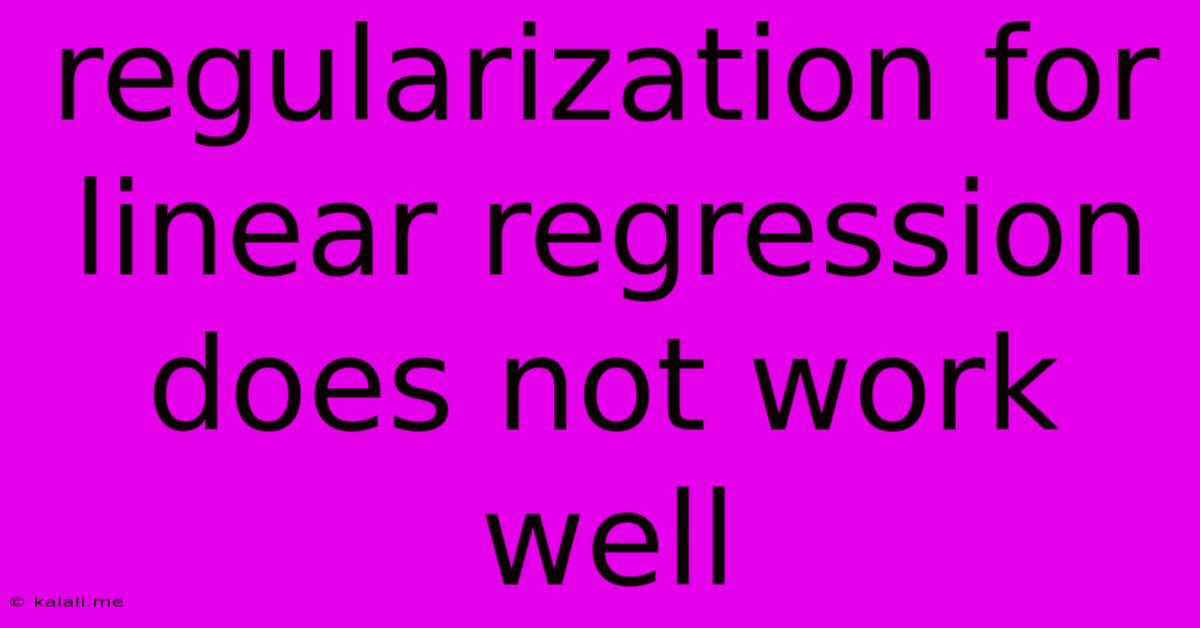Regularization For Linear Regression Does Not Work Well
Kalali
May 23, 2025 · 3 min read

Table of Contents
When Regularization for Linear Regression Fails: Understanding the Limitations
Regularization techniques, like Ridge and Lasso regression, are frequently lauded for their ability to prevent overfitting in linear regression models. However, the reality is more nuanced. While incredibly useful in many scenarios, regularization isn't a silver bullet and can even hinder performance under specific circumstances. This article delves into the situations where regularization for linear regression may not yield the desired results, exploring the underlying reasons and offering potential alternative solutions.
Meta Description: Discover why regularization techniques like Ridge and Lasso regression sometimes fail to improve linear regression models. Learn about scenarios where they underperform and explore alternative approaches for better predictive accuracy.
Regularization methods add penalty terms to the ordinary least squares (OLS) cost function, shrinking coefficients towards zero. This reduces model complexity and prevents overfitting by discouraging the model from learning noise in the training data. But this very mechanism can be detrimental in certain situations.
Scenarios Where Regularization Underperforms
-
High Variance in Features: When features exhibit very high variance, regularization can disproportionately shrink coefficients, potentially masking genuine relationships between predictors and the response variable. The penalty term might unfairly penalize large coefficients associated with truly important features. This is particularly true for Lasso regression, which performs feature selection by setting coefficients to zero. A critical predictor with high variance might be wrongly discarded.
-
Insufficient Data: Regularization relies on the data to guide the coefficient shrinkage. With limited data, the estimated coefficients are already inherently uncertain. Adding a regularization penalty further compounds this uncertainty, potentially leading to suboptimal models that perform worse than simple OLS.
-
Multicollinearity (But Not Always): While regularization is often recommended for handling multicollinearity (high correlation between predictors), its effectiveness isn't guaranteed. In severe cases of multicollinearity, regularization might still produce unstable coefficient estimates, although it might improve prediction accuracy slightly by reducing variance.
-
Incorrect Choice of Regularization Parameter (λ): The success of regularization heavily depends on choosing the appropriate regularization parameter (λ). A value that's too small will have little effect, while a value that's too large will lead to excessive shrinkage and potentially underfitting. Appropriate λ selection through techniques like cross-validation is crucial. If this process isn't done carefully, performance can suffer.
-
Non-Linear Relationships: Regularization assumes a linear relationship between predictors and the response. If the true relationship is non-linear, regularization applied to a linear model will simply fail to capture the underlying pattern. Consider feature engineering to incorporate non-linear terms or explore non-linear models instead.
Alternatives When Regularization Fails
When regularization doesn't work as expected, exploring alternative strategies is necessary:
-
Feature Selection Techniques: Before applying any regression model, carefully select relevant features. Techniques like Principal Component Analysis (PCA) or recursive feature elimination can help reduce dimensionality and improve model performance.
-
Non-Linear Models: If non-linearity is suspected, consider using models better equipped to handle them such as Support Vector Machines (SVMs) with non-linear kernels, decision trees, or neural networks.
-
Robust Regression: If outliers are suspected to be heavily influencing the model, robust regression techniques can be employed. They are less sensitive to outliers compared to ordinary least squares.
Conclusion
Regularization is a powerful tool, but it’s not always the best solution for improving the performance of linear regression models. Understanding the situations where it might falter is vital. By carefully examining the data, considering alternative approaches, and paying close attention to parameter selection, we can build more accurate and reliable predictive models. Remember that effective model building requires a nuanced understanding of the data and the limitations of various techniques.
Latest Posts
Latest Posts
-
How Much Does A Water Bottle Weight
Jul 03, 2025
-
How Many Inches Is Half A Yard
Jul 03, 2025
-
How Old Are You If Your Born In 1996
Jul 03, 2025
-
How Many Water Bottles In 64 Ounces
Jul 03, 2025
-
How Many Cups Is 16 Oz Of Peanut Butter
Jul 03, 2025
Related Post
Thank you for visiting our website which covers about Regularization For Linear Regression Does Not Work Well . We hope the information provided has been useful to you. Feel free to contact us if you have any questions or need further assistance. See you next time and don't miss to bookmark.